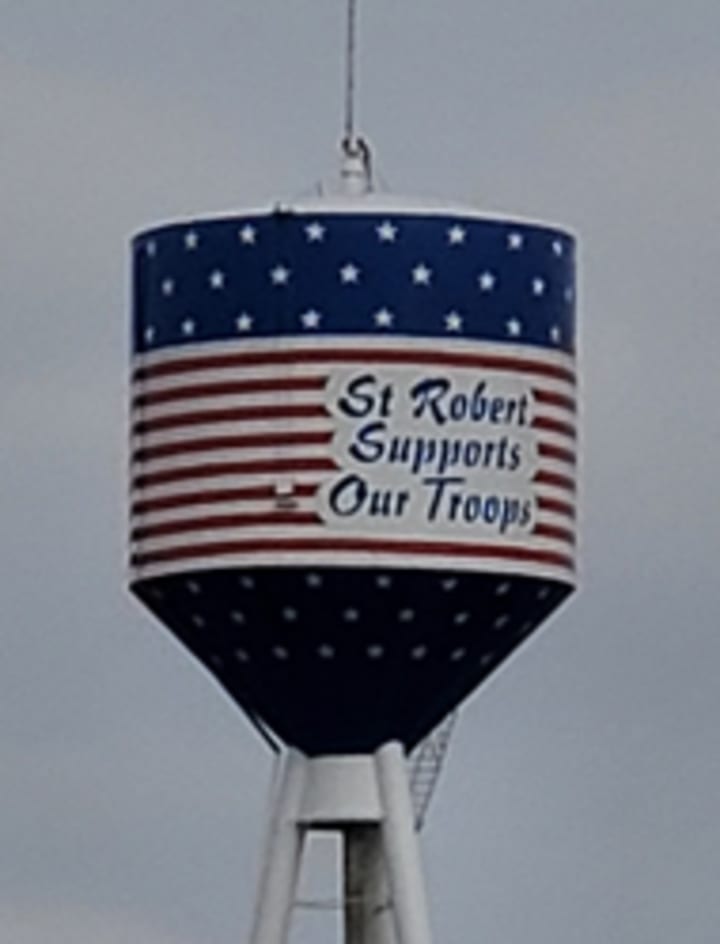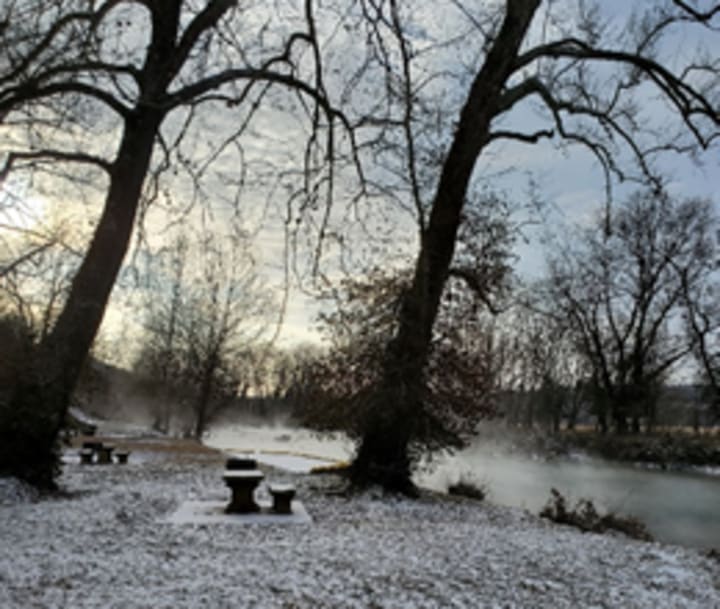
This is a tale of two cities, St. Robert and Waynesville, located in Pulaski County Missouri. Two small towns that form one community, where the unwritten motto is, “Serving those who serve.”
Less than one half of one percent of American citizens are active-duty military. But if you live in St. Robert or Waynesville, you are going to be around military a lot! That’s because Fort Leonard Wood, a military base is located just outside St. Robert. Fort Leonard Wood was built as a training base in the 1940s, right before World War II. Now it is home to the Army Chemical, Engineer and Military Police training schools, as well as units from the Air Force, Navy and Marines. Over 80,000 soldiers are trained there each year. It’s also home to nearly 6,000 “permanent party” military (those who are stationed here for duty, not just for training), along with their families and the 3,000 plus civilians who work with them.
With a combined population of just over 11,000, St. Robert and Waynesville are not big cities with big resources. But they have something most big cities don’t, a heart to help. This small town, rural area in mid-Missouri, is the kind of place where you often find a lack of diversity and a distrust of outsiders, but St. Robert/Waynesville could not be further from that! Here you will find an attitude of service and gratitude; an acceptance of people from all over; neighbors helping neighbors – even the ones they don’t know!
The community has welcomed the military with open arms, although it wasn’t always that way. In the 1940s people were a little leery of all the change and growth that came with Fort Leonard Wood, but over the years this has become one of the most supportive communities anywhere. St. Robert wasn’t even a town when Fort Leonard Wood was built, it wasn’t incorporated as a Village until 1951. It essentially grew up around Fort Leonard Wood. Waynesville is much older, dating back before the Civil War. A few older buildings remain, such as the Old Stagecoach Stop, which was used as a hospital during the Civil War. Waynesville was also in full swing when Route 66 came through. there are several attractions in the 33 miles of Route 66 that travel through Pulaski County, Waynesville the county seat, houses the county courthouse. The first courthouse, built in 1903, and one of only two originals remaining on Route 66, is now a museum where you can see the furnishings from the early 1900s and learn about a time long past.



Although initially unsure, both towns grew to appreciate and support Fort Leonard Wood. One water tower in St. Robert has the slogan, “We Support Our Troops”. Many businesses in the area offer discounts for service members, often 10 to 15% off a meal or service. When you are out, you will often hear people telling a service member, “We appreciate your service.”

Waynesville found a way to honor the military, as well as provide for special needs children, through the Little Heroes Playground. It has a military theme, honoring the Army, Air Force, Navy and Marines, and is a special playground designed to be accessible to all children. The construction is such that wheelchairs can easily move across the ground and around the equipment. There are swings that support a child who cannot hold their body up, and the playground equipment is not the typical metal construction – this is designed so it doesn’t create sounds that are difficult for children with autism. There is also a fence around the playground to assist parents in keeping their children safe. The sign at the entrance to the playground reads, “Helping every kid be active, be social and belong!”


A park like this is not cheap, but the community came together to help create this very important addition to the area. Grants, some funds from the city, and over $50,000 raised and/or donated by community organizations, businesses and individuals made this dream a reality. And the old playground equipment was given to a small school in the county that did not have playground equipment and could not afford to get any. This is just one example of the way the community comes together to help.
When the COVID pandemic was fresh, the Facebook page, ‘Pulaski County Swap Group’ was a lifeline for many. The page was a place where anyone could post things they needed, and others would respond if they could help. Everything from people who were not able to leave the house to purchase groceries – people would respond with offers to pick things up for them, to people who had lost their jobs and could not afford food – businesses would offer to donate food to those in need, there was an overwhelming response from people willing to help. A single woman who needed work done on her car, an older person who needed someone to help. There were so many different requests and responses. It was heartwarming to see the community come together to support each other. The need is different now, but the page is still active and allows for requests of any kind. It now provides community information, such as school and business closings during bad weather, law enforcement information, and can be used by businesses to advertise specials or let people know when they are hiring. Information is posted when free produce boxes are being distributed. It is still an excellent place to post for anyone looking for help or advice with something.
This is a community that not only honors the military and helps each other, but also welcomes international visitors. The local military base is part of a program that provides training to international officers. The program has been in existence since the 1940s and is designed to promote peace and human rights with our allies. These officers come from many different countries and are here on average five to six months. There is a program for local people to meet and become friends with these officers and help them make the adjustment to life in the United States. The community here is very supportive in this program, and many local businesses go out of their way to help as well. Many of the officers come from countries where the weather is always warm, and if they come here during the winter it is very hard on them. One officer commented that a coat is such a waste of money. They have to have it here, but they have no use for it when they return home. One local woman, who does many things to help the internationals, immediate came up with an idea and her church is implementing it now. To provide a coat exchange. The officers can come and pick out a coat to use while they are here, then return it when they leave. For someone whose salary is often unbelievable small, not having to spend a large amount on a coat is a major blessing!

There are several things to see and enjoy in the area, such as the Trail of Tears Memorial. It is a recent addition to the community. Excerpts of journals of three men who traveled on the marches were found, and verified that the Cherokee camped in the Laughlin Park area. A monument was created, and working with the US National Park Service, the stop in Waynesville was added as a Certified Historic Site on the Trail of Tears National Historic Trail. The dedication of the memorial was very moving, with not only local officials and representatives from the Trail of Tears National Historic Trail, but also special guests, the Remember the Removal Cherokee bike riders. They are a group of young Cherokee who ride bikes every year, following the Trail of Tears, to honor and remember the hardship of the Cherokee who were forced to make that march, and those who did not survive the march.

The memorial, located in Laughlin Park, is next to the Roubidoux River, one of the beautiful natural resources in the area. It provides a place for fishing, floating, canoeing, swimming and just relaxing. Nature is one of the biggest attractions in the area, and the reason many of the military wind up coming back here to retire. Nature and caring people create a pretty good community! A community that has a spirit of giving and helping, honoring and serving – not just the locals or people they know – but everyone. That’s why I’m proud to call the St. Robert/Waynesville community my home.


About the Creator
Kay Lowder
Hi, I'm Kay, a 50+ grandmother who loves life! I love to travel, read, write, and sit on the back porch and watch the sunset. I hope you enjoy my stories, I'd love to hear from you, and if you'd like to leave a tip, that would be great too!






Comments
There are no comments for this story
Be the first to respond and start the conversation.